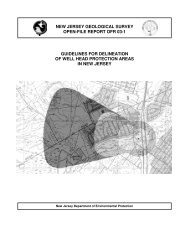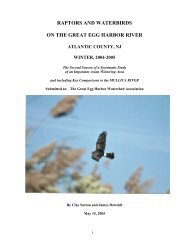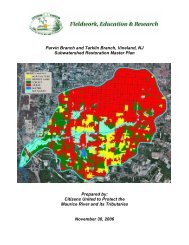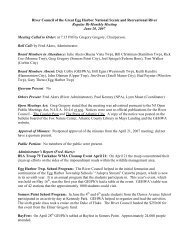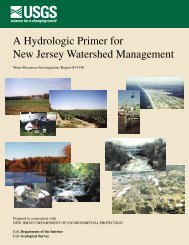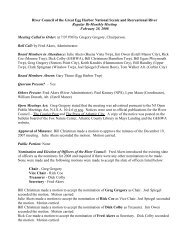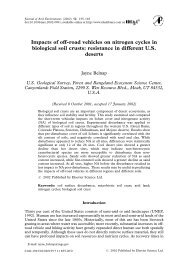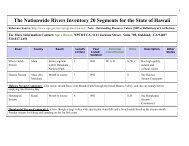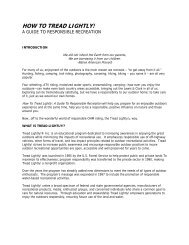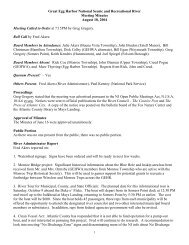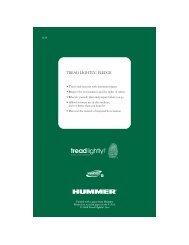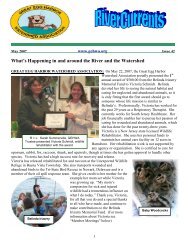November - Great Egg Harbor Watershed Association
November - Great Egg Harbor Watershed Association
November - Great Egg Harbor Watershed Association
You also want an ePaper? Increase the reach of your titles
YUMPU automatically turns print PDFs into web optimized ePapers that Google loves.
<strong>November</strong> 2007 www.gehwa.org Issue 44<br />
What’s Happening in and around the River and the <strong>Watershed</strong><br />
GREAT EGG HARBOR WILD AND SCENIC RIVER: The <strong>Great</strong> <strong>Egg</strong> <strong>Harbor</strong> River Helped Decorate<br />
the Official White House Christmas Tree<br />
This year, First Lady Laura Bush asked the <strong>Great</strong> <strong>Egg</strong> <strong>Harbor</strong> River to decorate a<br />
large gold ball to be used as a decoration on the official White House Christmas Tree.<br />
The theme for the decorations is "Holiday in the National Parks". All 391 Units of the<br />
National Park System, from across the nation, were asked to decorate a ball. The<br />
<strong>Great</strong> <strong>Egg</strong> <strong>Harbor</strong> River is one of these Units.<br />
L>R Julie Akers &<br />
Jennifer (Akers)Docimo<br />
Jennifer (Akers) Docimo designed and painted the artwork that decorated the <strong>Great</strong> <strong>Egg</strong> <strong>Harbor</strong><br />
River ornament. The images on the ball included a Swamp Pink plant, a Pine<br />
Barrens Tree Frog, an Otter, and green landscapes with gold water.<br />
Jennifer submitted the ornament, and she and a guest were invited to<br />
the White House to celebrate the tree. On <strong>November</strong> 28, Jennifer and<br />
Julie Akers, her mother, visited the White House in Washington DC<br />
and saw the National Park System tree displayed in the Blue Room. The tree, an<br />
eighteen-foot Fraser fir, was decorated with the 347 holiday<br />
ornaments that were supplied by the different Units of the<br />
National Park Systems. Due to the size of the tree and a large<br />
crowd, Jennifer and Julie could not find the <strong>Great</strong> <strong>Egg</strong>’s<br />
ornament on the tree. The ornaments were hand-decorated by artists whose designs<br />
represent America's national parks, memorials, seashores, historic sites and monuments.<br />
Each ornament reflects the diversity of our national landscapes and the many wonderful and uniqu<br />
found from sea to shining sea!<br />
1<br />
e treasures<br />
The following websites offer additional information: http://www.whitehouse.gov/news/releases/2007/11/20071129-<br />
18.wm.v.html or http://www.whitehouse.gov/holiday/2007/index.html<br />
SOME FUN FACTS ON THE 2007 HOLIDAY SEASON AT THE WHITE HOUSE<br />
• Guests touring the White House during the Holidays: 60,000<br />
• Number of Christmas Cards Sent by President and Mrs. Bush: 895,000<br />
• Christmas Trees: 33 (From Maryland, North Carolina, Pennsylvania , and West Virginia)<br />
• Feet of Garland : 862<br />
• Handmade Tamales: 10,000<br />
• Wreaths: 232<br />
• Pounds of Crab: 700<br />
• Amaryllis: 514<br />
• Pounds of Asparagus: 600<br />
• Christmas Cookies: 20,000<br />
• Pounds of Green Beans: 400<br />
• Assorted Holiday Cakes: 700<br />
• Gallons of <strong>Egg</strong>nog: 320<br />
• Pounds of Shrimp: 1,000
ATLANTIC COUNTY-Dorothy Preserve Cleanup: Brownie Troop 3755<br />
from the Lenape Pines Community<br />
spent Saturday morning, October 21,<br />
cleaning up the roads surrounding<br />
the Dorothy Reserve. GEHWA<br />
helped the Brownie Troop organize<br />
the event. Joining Troop 3755 were<br />
Cub Scout Pack 316, Lenape Pines<br />
Junior Cadet Troop 16654, and Brown Troop 42112. There were 15<br />
participants. The find of the day was an intact deer skeleton minus<br />
the head, which was found a short distance from the body. After<br />
some expressions of revulsion, time was spent examining the skeletal remains.<br />
SOMERS POINT-Dawes Avenue School Save the Bluffs<br />
Project Update: The fall clean up of weeds and trash from<br />
the Kennedy Park bluffs took place on <strong>November</strong> 5 th and 7 th<br />
by the 4 th and 6 th grade classes respectively from Dawes.<br />
The 4 th grade class was assigned an area of the Bluffs to<br />
clean up.<br />
By the<br />
end of the<br />
day they<br />
The SUPER 6 th graders - “We did it!”<br />
The FANTISTIC 4 th graders –<br />
Proud of their debris pile.<br />
had achieved their goal. They were spectacular. It rained on<br />
<strong>November</strong> 6 th , so the work day for the 5 th grade class was<br />
cancelled. As a result of the missed day, the 6 th grade class<br />
was challenged to try and accomplish the remaining clean up<br />
work. Thus motivated, they tackled both the 5 th and 6 th grade<br />
areas and achieved their goal. WOW. In addition to the<br />
clean up, the students classified animals and plants,<br />
identified invasive species, created landscape drawings, and<br />
wrote poetry.<br />
An inventory was taken after the clean up of the bushes that were planted by the Dawes students in the spring of<br />
2006. 160 bushes were originally planted. Forty-two bushes will need to be replaced.<br />
STOCKTON WATER WATCH PARTNERSHIP: During the fall<br />
semester GEHWA worked in partnership with Richard Stockton<br />
College’s Water Watch program. The Water Watch program, a<br />
partnership between NJPIRG and AmeriCorps, equips students and<br />
community members so they can work towards improving water<br />
quality through education and action. GEHWA worked with the Water<br />
Watch participants: by instructing interns and students where and how<br />
to monitor streams and by providing tools for teaching environmental<br />
education. On December 7 th four student interns presented their stream<br />
monitoring data. This data will be used by future Water Watch interns.<br />
L>R John Spadola, Matt Donnelly,<br />
Pete Gotta, & Elizabeth Kaugerts<br />
PINELANDS DISCOVERY FESTIVAL: GEHWA had a table at the festival on October 7, 2007. The<br />
festival was sponsored by the Pinelands Preservation Alliance (PPA). The event was supported by crafters and<br />
a diverse group of nonprofit organizations.<br />
2
BIRD SURVEY: RC Cape May Holdings, LLC, which operates the B.L. England Generating Station, recently<br />
contributed $3,000 for the 2007-2008 bird survey to the <strong>Great</strong> <strong>Egg</strong> <strong>Harbor</strong> <strong>Watershed</strong> <strong>Association</strong>. This<br />
contribution will assist GEHWA in continuing its valuable environmental research for the final year of a five<br />
year study. The water birds and raptors of the <strong>Great</strong> <strong>Egg</strong> <strong>Harbor</strong> River <strong>Watershed</strong> are one of the many<br />
“Outstandingly Remarkable Resource Values” that enabled designation of the river into the National Wild and<br />
Scenic Rivers System in 1992. This continuing study provides information on the status and trends of water<br />
birds and raptors in the river corridor to assure their long-term protection, and promote the importance of wild<br />
places in the American landscape, especially here in South Jersey.<br />
Special Note: The 2006-2007 bird survey for the <strong>Great</strong> <strong>Egg</strong> <strong>Harbor</strong> River and the Mullica River has been<br />
completed. This report is posted on our website: http://www.gehwa.org/newsletter.htm.<br />
TUCKAHOE - Eagle Scout Osprey Project: On Sunday, <strong>November</strong> 4 th , Adam<br />
Day, from Boy Scout Troop 79, erected five osprey<br />
platforms on the Tuckahoe River for his Eagle<br />
Scout project. Adam raised funds to build three of<br />
the platforms, and Fred Akers donated two<br />
platforms that he had previously built. While<br />
traveling by boat to the location where the first<br />
platform was to be erected, two Bald Eagles were<br />
observed flying overhead (a heartwarming event<br />
Adam Day<br />
while embarking on an Eagle Scout project).<br />
Equally moving was the chiming of church bells at the precise moment the<br />
pool of the platform settled into place. The young men from Troop 79 were<br />
terrific to work with.<br />
BUENA VISTA TOWNSHIP: YOU ARE INVITED! During the hunting season (now<br />
until the end of January) volunteers are needed to walk around the property line of<br />
Unexpected Wildlife Refuge. The best times to walk are early in the morning or in the<br />
afternoon until dusk. The refuge is an inviolate sanctuary for wildlife. Hunting is<br />
prohibited. Please donate a few hours of your time. Contact Sarah Summerville at 856-<br />
697-3541 to setup a time.<br />
Don’t forget!<br />
The next members’ meeting is at 7:00 pm on Tuesday January 22 , 2008 at the Warren Fox<br />
Nature Center in Estell Manor. The program will revisit the work of Warren E. Fox, an<br />
active environmentalist who contributed thousands of hours to a better understanding<br />
of the New Jersey Pinelands, and other advocates that promoted the Wild and Scenic<br />
designation of the <strong>Great</strong> <strong>Egg</strong> <strong>Harbor</strong> River.<br />
Please mark your calendars.<br />
Special Notice to All Members: From: Julie Akers, President GEHWA<br />
RE: ANNUAL MEMBERSHIP MEETING: Tuesday MARCH 25, 2008 AT 7:00 FOX NATURE<br />
CENTER, RT. 50, ESTELL MANOR. Please plan on attending.<br />
3
Where’s the<br />
pollution?<br />
Transferring Pollution to Protect the Pinelands<br />
By: Fred Akers<br />
Prior to the adoption of the Pinelands Comprehensive Management Plan<br />
(CMP), the U.S. Department of the Interior published a full Environmental Impact<br />
Statement (EIS), including an analysis of alternatives. The final EIS for the<br />
Pinelands National Reserve analyzed the following five alternative management<br />
strategies: No Plan Alternative, Proposed CMP Alternative, More Preservation<br />
River Administrators Desk<br />
Oriented CMP, More Development Oriented CMP and Federal/State Management<br />
Alternative.<br />
There was serious concern in this analysis whether any of these alternatives for Pinelands protection<br />
would actually work on an ecosystem basis. It was already recognized that pollution and other adverse impacts<br />
that occur in one part of an ecosystem would readily affect other parts of the ecosystem.<br />
Given the importance of surface water and ground water to the Pinelands ecosystem, there was concern<br />
that significant changes in water quality and quantity would seriously compromise Pinelands natural values in<br />
the future. This in-turn would defeat the intent of the federal legislation of preserving, protecting, and enhancing<br />
the natural and cultural resources of the Pinelands National Reserve.<br />
The outcome of the EIS was the selection of a CMP that was essentially a compromise between a More<br />
Preservation Oriented CMP and a More Development Oriented CMP, where the “preferred alternative” was not<br />
the “environmentally preferable” alternative. The principal mechanism to protect the Pinelands under the<br />
adopted CMP was a zoning scheme that would transfer development and its associated pollution from the<br />
Preservation and Forest Areas to Regional Growth Area, Pinelands Towns and Villages, and Rural<br />
Development Areas. The possible negative and positive consequences of this plan were recognized in the EIS:<br />
“It is expected that Rural Growth Districts, Regional Growth Districts, and Pinelands Villages<br />
and Towns would contribute to some loss of water quality as discussed under the No Plan<br />
alternative. Concentrating development would potentially provide for more efficient waste<br />
management, and leave the large Preservation Area and Forest District regions in a pristine state.<br />
Proposed CMP water quality standards for these areas are very stringent, and do not allow for<br />
any pollutant impact. Water standards for the other districts are not as stringent. Data presented<br />
under the discussion of pollutants shows that they are already present in moderately developed<br />
areas and agricultural lands”.<br />
An analysis of management area acreage reveals that the Rural Development Areas, Regional Growth<br />
Areas, and Pinelands Villages and Towns make up over 30% of the Pinelands under the jurisdiction of the<br />
CMP. So in essence, one-third of the Pinelands were planned to be sacrificed with regards to water quality, to<br />
protect two-thirds of the Pinelands in the Preservation and Forest Areas.<br />
Twenty-six (26) years later, it appears that the original ecosystem protection concerns were well<br />
founded---indeed, understated. For example, a 2005 report published by the Pinelands Commission science<br />
staff on the <strong>Great</strong> <strong>Egg</strong> <strong>Harbor</strong> <strong>Watershed</strong> Management Area (WMA) concluded that,<br />
“Most survey sites in the <strong>Great</strong> <strong>Egg</strong> <strong>Harbor</strong> River WMA displayed some level of aquatic<br />
degradation. Non-Pinelands fish, anuran, and plant species were widespread in the <strong>Great</strong> <strong>Egg</strong><br />
<strong>Harbor</strong> WMA and few sites could be characterized as reference sites. The results of this study<br />
highlight the scarcity of Pinelands streams displaying characteristic water quality and native<br />
aquatic communities in the <strong>Great</strong> <strong>Egg</strong> <strong>Harbor</strong> River WMA, which represents almost 25% of the<br />
Pinelands National Reserve.”<br />
Unfortunately, the <strong>Great</strong> <strong>Egg</strong> <strong>Harbor</strong> <strong>Watershed</strong> includes 110,862 acres of Forest Area (12% of the<br />
Pinelands) that are now degraded. Since the CMP intended to protect the Forest Area and the Preservation Area<br />
by transferring development outside of these areas, it is time to assess the cumulative degradation in the<br />
“protected areas” and ask if the CMP is adequate protection.<br />
Given the incredible amount of complications and competing interests in the environmental protection<br />
of almost 1 million acres, the implementation of the CMP has provided a substantial firewall to slow and delay<br />
4
the rate of environmental degradation in the Pinelands. But water quality and other environmental parameters<br />
in the Pinelands are continuing to be degraded, despite the best intentions. Increased protective efforts will be<br />
required to just hold the line on future degradation, and making advances against this degradation will require<br />
forward thinking and strict adherence to the CMP.<br />
**Member Meetings**<br />
And<br />
“What’s in Our Backyards?”<br />
WHAT CAUSES FLOODING<br />
On September 25 th River Administrator Fred Akers showed slides of the flooding in the watershed from the<br />
April “Northeaster”. The <strong>Great</strong> <strong>Egg</strong> <strong>Harbor</strong> River swelled to record levels and homes were flooded in<br />
Weymouth and near the dam at Lake Lenape. The damage was so severe that Atlantic County was<br />
designated a disaster area by the Federal Emergency Management Agency (FEMA). Using Geographic<br />
Information Systems (GIS), Fred also demonstrated how the changing land uses within the watershed are<br />
impeding its ability to mitigate flood waters. Using the FEMA flood plain mapping layers, Fred also explained<br />
that 156 square miles of the 627 square mile <strong>Great</strong> <strong>Egg</strong> <strong>Harbor</strong> <strong>Watershed</strong> is within the flood hazard area.<br />
BIRD STEWARDSHIP<br />
Clay Sutton, a Naturalist, Biologist, Writer, and Lecturer, who has studied birds in the wild for over 30<br />
years, presented a great program on <strong>November</strong> 27 th . Clay gave the highlights of the 2006-2007 bird<br />
survey. He also provided an update of GEHWA’s on-going baseline documentation of the status and<br />
trends of bird use and populations on the <strong>Great</strong><br />
<strong>Egg</strong> and Mullica Rivers. Included in Clay’s<br />
program were many slides of raptors in flight.<br />
For some of us, identifying raptors in flight is no<br />
easy undertaking. But after viewing Clay’s<br />
many slides of airborne raptors, that endeavor<br />
may be less difficult.<br />
Which is the Rough-legged Hawk and<br />
which is the Osprey? Answer below.<br />
Mommy Cat a.k.a. Houdinis<br />
and Her Little Houdinies<br />
By Lynn Maun<br />
I am sure that many of you have been visited at one time or another by a stray or feral<br />
animal. Last fall, a feral cat and her litter of kittens took up residence in my stable.<br />
Her three kittens would often take refuge in the wood chipper - stored in one of the<br />
stalls - whenever a human approached. As time passed, I attempted to entice the<br />
kittens with food so they would grow accustomed to human contact. I also endeavored<br />
to find homes for the kittens. Mommy Cat was not content with her kittens<br />
approaching me so one day she took them into the woods, and the kittens were never<br />
seen again. As the months passed, I fed Mommy Cat whenever she showed up in my<br />
yard.<br />
Late last winter, Mommy Cat had another litter of kittens. By this time she was appearing daily for a meal. She<br />
gave birth in the hollowed out base of an Oak tree on my property. This second litter met with the same fate at<br />
the first. I had contemplated trying to capture Mommy Cat to have her spayed, but when the kittens failed to<br />
survive I did not pursue it. In early summer, Mommy Cat appeared to be pregnant once again. I do not know<br />
5
where she had her kittens, but one day in September four cute bundles of fur were playing hide-n-seek with me<br />
while I gave Mommy Cat her breakfast (she was now getting two meals a day). I assumed these kittens would<br />
meet with the same fate as the others. What I didn’t take into account was that Mommy Cat had become<br />
accustomed to getting two meals a day and had no intention of taking her kittens into the woods to teach them<br />
how to fend for themselves. Instead she and her kittens would stare at my house until I came out to feed them.<br />
As the kittens continued to thrive, it was now time to take action. Mommy Cat needed to be captured and<br />
spayed. Mommy Cat is feral, even after feeding her for a year I cannot touch her. So, Mommy Cat was<br />
trapped and taken on, possibly, her first car ride. When I brought her home from the veterinarian’s, I put her in<br />
what I thought was a secure enclosure so that she would have a chance to heal. Within one half hour she had<br />
escaped, hence the name Houdinis. After several days’ absence, Mommy Cat cautiously approached my back<br />
door looking for her dinner. She looked none the worse for wear.<br />
In the interim, Mommy Cat’s four kittens (3 tabbies and 1 black)<br />
continued to appear for meals twice a day. I thought I could capture<br />
the kittens and take them to my county SPCA. But, they would not<br />
take the kittens, and the other animal shelter in the county told me<br />
they would euthanize the kittens. I later learned the SPCA would have<br />
done the same. After many calls to an assortment of No Kill animal<br />
rescue organizations, I came to the realization that if I did not want to have the kittens destroyed my only other<br />
alternative was to have the kittens neutered (all males) and then release them onto my property. Following the<br />
kittens sterilization, they spent the night at the veterinarians’. When I brought them home the next day, I<br />
planned to confine them in the same enclosure that had been built for Mommy Cat. I reinforced the opening I<br />
“thought” she had escaped from (I even climbed inside and checked for openings in the wire), and proceeded<br />
to transfer the kittens from a large dog crate into the larger enclosure. The kittens found an opening in the wire<br />
that I had missed and were out of the enclosure within five seconds. I think that Mommy Cat had showed her<br />
little Houdinies the escape hatch. I now have a feral colony of five cats on my property.<br />
Well that’s what has been happening in my backyard. What about yours? Let me know.<br />
lynnkmaun@comcast.net.<br />
<strong>Great</strong> <strong>Egg</strong> <strong>Harbor</strong> <strong>Watershed</strong> <strong>Association</strong><br />
Julie Akers, President (856) 697-6114<br />
Fred Akers, Administrator (856) 697-6114<br />
P. O. Box 109; Newtonville, NJ 08346<br />
Email: fred_akers@gehwa.org<br />
Web Site: www.gehwa.org<br />
Lynn Maun, Coordinator (856) 453-0416<br />
Email: lynnkmaun@comcast.net<br />
National Park Service<br />
Paul Kenney (215) 597-5823<br />
Paul_Kenney@nps.gov<br />
NJDEP <strong>Watershed</strong> Management Office<br />
Robert Mancini (609) 777-0580<br />
Atlantic County Department of Planning<br />
Bob Lindaw (609) 645-5898<br />
US Army Corps of Engineers (215) 656-6725<br />
NJDEP Regulatory Office for Atlantic County<br />
(609) 292-8262<br />
NJDEP Enforcement Officer<br />
Kevin Brown (732) 255-0787<br />
Pinelands Commission<br />
Main Number (609) 894-7300<br />
NJDEP Hotline: 1-877 WARN DEP<br />
Answer: Picture on the left is<br />
an Osprey, and on the right a<br />
Rough-legged Hawk<br />
6
Wednesday, December 19, 2007<br />
<strong>Great</strong> <strong>Egg</strong> <strong>Harbor</strong> NS & R River Council<br />
Meeting<br />
Tuesday, December 25, 2007 (Cancelled)<br />
Trustees<br />
Tuesday, January 22, 2008<br />
GEHWA Members Meeting<br />
Saturday, February 2, 2008<br />
Eagle Festival, Cumberland County<br />
Wednesday, February 20, 2008<br />
<strong>Great</strong> <strong>Egg</strong> <strong>Harbor</strong> NS & R River Council<br />
Meeting<br />
Tuesday, February 26, 2008<br />
Trustees<br />
Tuesday, March 25, 2008<br />
Annual GEHWA Members Meeting<br />
Wednesday, April 16, 2008<br />
<strong>Great</strong> <strong>Egg</strong> <strong>Harbor</strong> NS & R River Council<br />
Meeting<br />
Calendar of Events 2007-2008<br />
Tuesday, April 22, 2008<br />
Trustees<br />
Sunday, April 27, 2008<br />
ACUA Earth Day<br />
Tuesday, May 27, 2008<br />
GEHWA Members Meeting<br />
Wednesday, June 18, 2008<br />
<strong>Great</strong> <strong>Egg</strong> <strong>Harbor</strong> NS & R River Council<br />
Meeting<br />
Tuesday, June 24, 2008<br />
Trustees<br />
Tuesday, July 22, 2008<br />
GEHWA Members Meeting<br />
Wednesday, August 20, 2008<br />
<strong>Great</strong> <strong>Egg</strong> <strong>Harbor</strong> NS & R River Council<br />
Meeting<br />
Tuesday, August 26, 2008<br />
Trustees<br />
Tuesday, September 23, 2008<br />
GEHWA Members Meeting<br />
Wednesday, October 15, 2008<br />
<strong>Great</strong> <strong>Egg</strong> <strong>Harbor</strong> NS & R River Council<br />
Meeting<br />
Tuesday, October 28, 2008<br />
Trustees<br />
Tuesday, <strong>November</strong> 25, 2008<br />
GEHWA Members Meeting<br />
Wednesday, December 17, 2008<br />
<strong>Great</strong> <strong>Egg</strong> <strong>Harbor</strong> NS & R River Council<br />
Meeting<br />
Tuesday, December 23, 2008<br />
Trustees<br />
Membership Information<br />
Your membership supports our mission and ensures our survival as a non-profit advocate, as we work to protect<br />
and preserve the <strong>Great</strong> <strong>Egg</strong> <strong>Harbor</strong> River and <strong>Watershed</strong> throughout the year. As a result of federal budget cuts,<br />
your support is needed now more then ever. Without you, we could not exist. Thank you for your support!<br />
Name/Organization: ___________________________________________________________________<br />
Street Address: ___________________________________________________________________<br />
City, State, and Zip: ___________________________________________________________________<br />
Phone Number: ___________________________________________________________________<br />
Email address: ___________________________________________________________________<br />
_____ Yes, I would like to receive notices by Email.<br />
Annual Membership: Individual: $10; Family: $15; Supporting: $35; Patron: $50; Corporate: $100<br />
Please mail this form along with your check to:<br />
<strong>Great</strong> <strong>Egg</strong> <strong>Harbor</strong> <strong>Watershed</strong> <strong>Association</strong>, Membership, P.O. Box 109, Newtonville, NJ 08346<br />
Give the Gift of a GEHWA Membership!<br />
It does not deplete any of our vital resources. But instead, it will help<br />
to preserve and protect our environment both today and in the future.<br />
Please note: In order for your donation to be tax deductible<br />
for 2007 it must be sent by the end of the year.<br />
Thank You<br />
7
z<br />
Newsletter from the <strong>Great</strong> <strong>Egg</strong> <strong>Harbor</strong> <strong>Watershed</strong><br />
In 2016 our Nation will celebrate the 100 Year<br />
Anniversary of the National Park Service<br />
<strong>Great</strong> <strong>Egg</strong> <strong>Harbor</strong> <strong>Watershed</strong> <strong>Association</strong><br />
P.O. Box 109<br />
Newtonville, NJ 08346<br />
8



